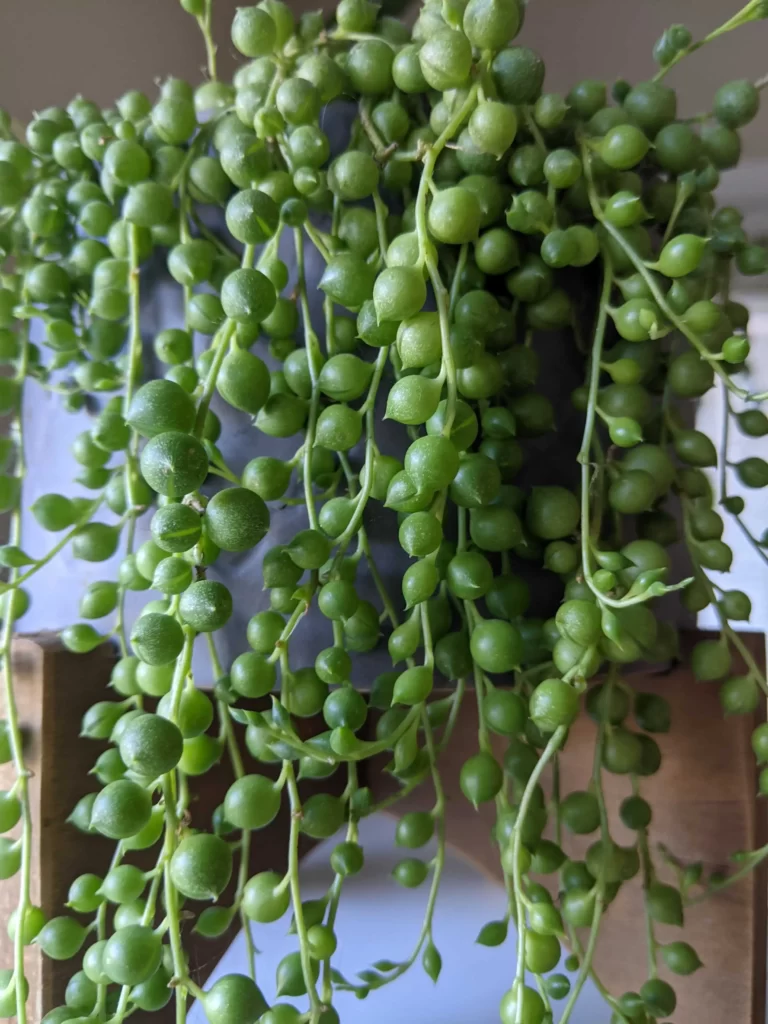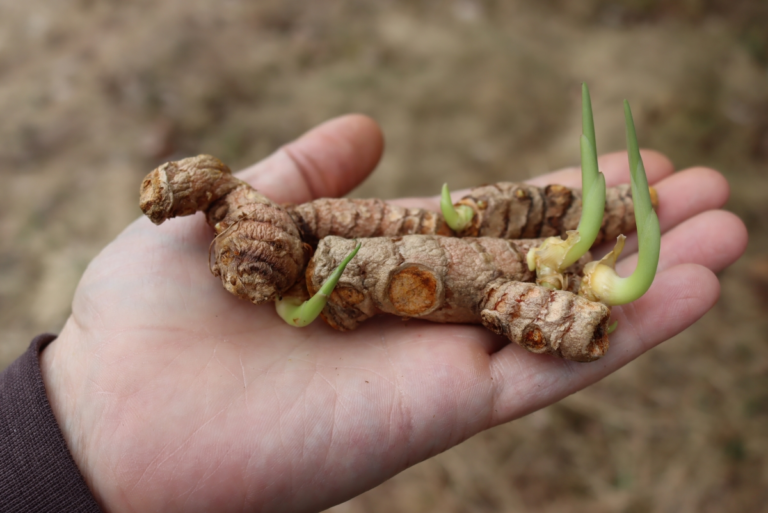If you’re a plant lover, you may have heard of the stunning string of pearls plant.

With its delicate cascading vines and spherical leaves resembling actual pearls, it’s no wonder why this succulent is such a popular choice for indoor gardeners.
However, growing and caring for one can be quite challenging. If you’re struggling to keep your string of pearls thriving, don’t fret! In this article,
we’ll discuss 10 reasons why your plant might not be growing as well as some helpful tips to get it back on track. So grab your gardening gloves and let’s dive in!
Issues commonly encountered in caring for the String of Pearls plant.
The string of pearls plant is a beautiful addition to any indoor garden, but it can be challenging to care for.

One common problem is overwatering, which can lead to root rot and yellow pearls.
Another issue is insufficient light, causing thinning stems and pearls.
To ensure your plant thrives, use a well-draining succulent soil mix and place it in a bright location with indirect sunlight.
Allow the soil to dry out before watering and make sure there are drainage holes in the pot.
If you notice shriveled leaves or dying stems, check for root damage and consider moving the plant to a brighter location or using a grow light.
With proper care and attention, your string of pearls will grow into a healthy and stunning plant.
- A video guide for indoor issues with a string of pearls is available.
If you’re struggling to keep your string of pearls plant alive, don’t worry!
Several common issues can cause problems for this delicate succulent.
In our String Of Pearls Issues Indoors Video Guide, we highlight 10 reasons why your plant may not be growing as well as it should.
From root rot caused by excess water to a lack of bright light, we cover all the basics of a string of pearls care.
One critical factor in keeping your plant healthy is ensuring it has well-draining soil and a pot with drainage holes.
Avoid using heavy potting soil and instead opt for a succulent soil mix that allows excess moisture to drain away from the roots.
Additionally, make sure to place your plant in a bright location with indirect sunlight and only water when the soil has completely dried out.
By following these tips and paying close attention to your plant’s needs, you can grow a thriving string of pearls that will add beauty and interest to any indoor space.
Check out our video guide today for more helpful advice on caring for this unique succulent!
2. The application of excessive or incorrect fertilizers could result in adverse effects.
Another common issue that can prevent your string of pearls from growing is over-fertilization or using the wrong type of fertilizer.
Succulents, including a string of pearls, don’t need a lot of feeding and can even suffer from fertilizer burn if given too much.
It’s best to fertilize only once in the spring and possibly again in mid-summer if necessary.
When choosing a fertilizer, look for one specifically formulated for succulents or cacti.
Avoid using regular houseplant fertilizers, which may be too heavy on nitrogen and phosphorus and not provide enough potassium.
Remember to always follow the instructions on the fertilizer package and use it sparingly.
With proper care and attention to your plant’s needs, you can help your string of pearls grow healthy and strong.
3. Frequent misting
Frequent misting of your string of pearls plant can harm it rather than help it grow.
This plant is native to dry regions and doesn’t require high levels of humidity.
Misting too often, especially at the crown, can cause rot and damage to the leaves.
Instead, focus on providing indirect sunlight and well-draining soil for your string of pearls.
If you’re concerned about the moisture levels in the soil, consider using a moisture meter to check before watering.
It’s also important to use a pot with drainage holes and a succulent soil mix that allows excess water to drain away from the roots.
By providing proper care and avoiding over-misting, you can help your string of pearls thrive in its environment.
4. The plant is exposed to hot and direct sunlight.
If your string of pearls plant is in direct sunlight, it may be struggling to grow.
This plant prefers bright, indirect light and can get sunburned if it’s exposed to too much direct sun.
If you’re keeping your plant near a window, make sure it’s at least 5-10 feet away from south or west-facing windows during the summer months when the glass can heat up.
In hotter climates like Arizona, the plant may need to be even further away from windows.
To help your string of pearls thrive, consider moving it to a brighter location with indirect sunlight or using a grow light if natural light isn’t sufficient.
You can also try relocating it to a north-facing window where it will receive plenty of bright but indirect light.
By providing proper lighting conditions and avoiding direct sun exposure, you can encourage healthy growth and prevent damage to your string of pearls plant.
5. There is no accommodation for the darker and cooler months.
As the seasons change and daylight hours decrease, your string of pearls plant may require different care.
During the fall and winter months, the plant may not receive as much natural light as it does during the spring and summer.
If you don’t adjust your care routine accordingly, your plant may struggle to grow.
To ensure your string of pearls stays healthy during the cooler months, consider moving it to a brighter location in your home or using a grow light to supplement natural light.
Be sure to back off on watering frequency since plants generally require less water when they’re not actively growing.
You can also use a moisture meter to check soil moisture levels before watering.
By providing proper care based on seasonal changes, you can help your string of pearls thrive year-round and avoid common issues like shriveled leaves or root damage.
6. The plant is placed in a container that exceeds its size.
One mistake many people make with their string of pearls plant is planting it in a pot that’s too big.
While you may think a larger pot means more room for growth, it can lead to issues like root rot.
The plant has a small root system and doesn’t require a lot of soil to grow.
When planted in a large pot, the soil may stay wet for too long, leading to root damage and mushy stems.
Instead, opt for a smaller pot that fits the size of your plant’s root ball.
This will ensure proper drainage and allow the soil to dry out between waterings.
If you’ve already planted your string of pearls in a large pot, consider repotting it into something smaller with fresh succulent soil mix.
This can help prevent further problems and promote healthy growth.
Remember, when it comes to pots for your string of pearls, less is often more.
7. Not enough light
One common reason why your string of pearls plant may not be growing is due to a lack of light.
These plants need bright, indirect light to thrive. If they are not getting enough light, they may begin to stretch out and become leggy.
This can cause the stems to break or become weak.
To remedy this issue, move your plant to a brighter location with more natural light.
You can also supplement with a grow light if necessary.
Avoid placing your string of pearls in direct sunlight as this can scorch the leaves.
Remember, a string of pearls plant is not a low-light plant and requires adequate lighting for proper growth.
With the right amount of light and proper care, you can have a healthy and thriving string of pearls plant in no time.
8. The plant was positioned at an excessively deep level within the pot.
Another reason why your string of pearls plant isn’t growing could be that it is planted too deep inside the pot.
When the crown of the plant is more than 1 inch below the top of the pot, it can cause a decrease in aeration and lead to root rot.
The stems may weaken and eventually rot out due to excess moisture.
To fix this problem, gently lift your plant from its pot and check if the root ball is too deep.
If so, replant it at a shallower depth in well-draining soil or succulent soil mix.
Ensure that there are adequate drainage holes in the pot to prevent water from accumulating at the bottom.
By planting your string of pearls at an appropriate depth, you can avoid root damage and promote healthy growth.
Remember to monitor soil moisture levels with a moisture meter and water only when the soil has dried out completely.
9. Too much water
One of the most common reasons why your string of pearls plant isn’t growing could be due to overwatering.
It’s easy to get carried away with watering, but this can lead to root rot and ultimately kill the plant.
Consistently moist soil can deprive the roots of a plant of oxygen which they also require.
To avoid overwatering, only water your string of pearls when the soil has gone nearly or completely dry.
You can check the soil moisture level with a moisture meter or by sticking your finger about an inch deep into the soil. If it feels dry, it’s time to water.
Ensure that your pot possesses sufficient drainage holes to enable the overflow of water.
Consider using well-draining soil or succulent soil mix to promote healthy growth.
Remember, it’s better to underwater than overwater your string of pearls plant – they are more tolerant of drought than excess moisture.
10. The plant had a higher moisture content at the time of purchase.
Another reason why your string of pearls plant may not be growing is if it was too wet when you first bought it.
Many big box stores and nurseries water their plants every day, which can lead to the soil being consistently moist.
This can cause root damage and hinder growth.
To prevent this issue, make sure to check the soil moisture level before purchasing a plant.
If it feels overly damp, it’s best to wait until the soil has had time to dry out before buying.
If you’ve already purchased a string of pearls plant that was too wet, don’t worry – with proper care, it can still thrive.
Make sure to only water when the soil is nearly or completely dry and provide adequate drainage for excess water to escape. Consider using well-draining soil or a succulent soil mix for optimal growth.






